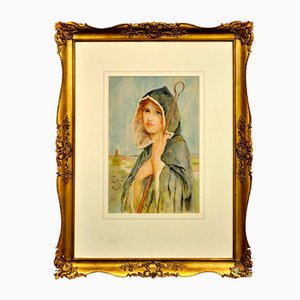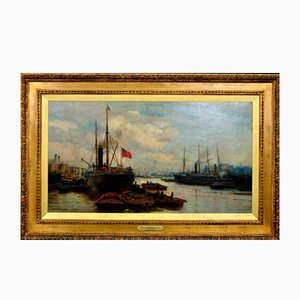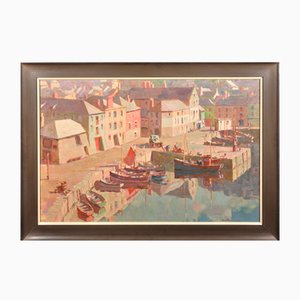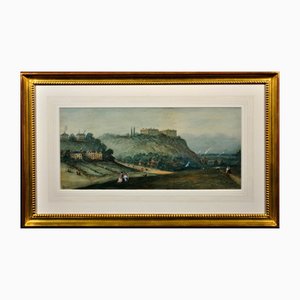Edgar Woollatt.
English ( b.1871 - d.1931 ).
Romany Gypsy Caravan At The Round House, Clifton Lane, Wilford, Nottingham.
Watercolour.
Signed Lower Left.
Image size 10.8 inches x 20.5 inches ( 27.5cm x 52cm ).
Frame size 17.5 inches x 27.2 inches ( 44.5cm x 69cm ).
This original painting is by the Nottingham artist Edgar Woollatt and dates from around 1910.
The watercolour is presented and supplied in a sympathetic and contrasting contemporary frame to suit the subject colouration (which is shown in these photographs) and behind non-reflective Tru Vue UltraVue® UV70 glass.
This antique piece is in superb condition. It wants for nothing and is supplied ready to hang and display.
The watercolour is signed lower left.
Edgar Woollatt was a successful landscape and figure painter, illustrator and designer. He was born in Radford, Nottingham on 8 February 1871, the son of William Woollatt, a Lace Designer. He studied at the Nottingham School of Art.
For many years Woollatt was a well-known watercolourist and at one time produced a considerable amount of commercial art for advertising and publishers. He became elected a full member of the Nottingham Society of Artists in 1908 and became its Vice President in 1929. He was also a member of the London Sketch Club.
Woollatt lived on Woodborough Road and had a studio on Newcastle Drive in The Park, Nottingham. He was a regular exhibitor in Nottingham and throughout the East Midlands. He had several works exhibited at the Royal Academy. One of these, entitled ‘Stirling Castle’ was purchased by the Nottingham Castle Art Gallery and forms part of its permanent collection.
Woollatt enjoyed playing tennis and golf and was a member of the local Reform Club. He died suddenly in his Studio in 1931 at the age of 60.
This charming original watercolour painting depicts the scene outside the building known as the Round House which used to stand on Clifton Lane in the Wilford district of Nottingham. The creamy stone walls of the building and its ornate windows give a glimpse of its quirky character. There is heavy foliage around the property and the house itself is perfectly framed between the branches of two large trees. In front of the Round House is a Romany gypsy traveller horse drawn caravan, perched on tall wooden wheels, and two figures, apparently engaged in conversation. There are half a dozen hens roaming freely on the grass verge. The painting is executed with a light, delicate touch and provides a reminder of life at the turn of the twentieth century. The palette suggests this is late summer.
The Round House was a picturesque little semi-circular castle, complete with battlements. It stood in the east bank of the river Trent, near to Fairham Brook. It was surrounded by apple trees, gooseberry bushes and raspberry canes. It served as a focal point for picnics and as a place for children to play. On summer evenings local people would buy a tea of eggs, bread, butter and fruit and eat it in the Round House grounds. The Round House was demolished in the 1960s.
Edgar Woollatt.
Englisch ( geb.1871 - gest.1931 ).
Wohnwagen der Zigeuner am runden Haus, Clifton Lane, Wilford, Nottingham.
Aquarell.
Signiert unten links.
Bildgröße: 27,5 x 52 cm (10,8 x 20,5 Zoll).
Rahmengröße 17,5 x 27,2 cm (44,5 x 69 cm).
Dieses Originalgemälde stammt von dem Nottinghamer Künstler Edgar Woollatt und wurde um 1910 gemalt.
Das Aquarell wird in einem sympathischen und kontrastreichen zeitgenössischen Rahmen präsentiert und geliefert, der zur Farbgebung des Motivs passt (die auf diesen Fotos zu sehen ist) und hinter entspiegeltem Tru Vue UltraVue® UV70 Glas.
Dieses antike Stück ist in hervorragendem Zustand. Es fehlt ihm an nichts und wird hängefertig geliefert.
Das Aquarell ist unten links signiert.
Edgar Woollatt war ein erfolgreicher Landschafts- und Figurenmaler, Illustrator und Designer. Er wurde am 8. Februar 1871 in Radford, Nottingham, als Sohn von William Woollatt, einem Spitzendesigner, geboren. Er studierte an der Nottingham School of Art.
Viele Jahre lang war Woollatt ein bekannter Aquarellist und produzierte eine Zeit lang eine beträchtliche Menge an kommerzieller Kunst für Werbung und Verlage. Er wurde 1908 zum Vollmitglied der Nottingham Society of Artists gewählt und wurde 1929 deren Vizepräsident. Er war auch Mitglied des London Sketch Club.
Woollatt wohnte in der Woodborough Road und hatte ein Atelier am Newcastle Drive in The Park, Nottingham. Er stellte regelmäßig in Nottingham und in den East Midlands aus. Mehrere seiner Werke wurden in der Royal Academy ausgestellt. Eines dieser Werke mit dem Titel "Stirling Castle" wurde von der Nottingham Castle Art Gallery erworben und ist Teil ihrer ständigen Sammlung.
Woollatt spielte gerne Tennis und Golf und war Mitglied des örtlichen Reformclubs. Er starb 1931 im Alter von 60 Jahren plötzlich in seinem Studio.
Dieses charmante Original-Aquarell zeigt die Szene vor dem Gebäude, das als Round House bekannt ist und früher in der Clifton Lane im Stadtteil Wilford in Nottingham stand. Die cremefarbenen Steinmauern des Gebäudes und seine verzierten Fenster geben einen Eindruck von seinem eigenwilligen Charakter. Das Grundstück ist dicht belaubt und das Haus selbst liegt perfekt eingerahmt zwischen den Ästen zweier großer Bäume. Vor dem Rundhaus steht ein von Zigeunern gezogener Wohnwagen auf hohen Holzrädern und zwei Figuren, die sich offenbar unterhalten. Auf dem Grünstreifen laufen ein halbes Dutzend Hühner frei umher. Das Gemälde ist mit leichter, zarter Hand gemalt und erinnert an das Leben zu Beginn des zwanzigsten Jahrhunderts. Die Farbpalette deutet auf den Spätsommer hin.
Das Round House war eine malerische, kleine, halbrunde Burg mit Zinnen. Es stand am Ostufer des Flusses Trent, in der Nähe des Fairham Brook. Es war von Apfelbäumen, Stachelbeersträuchern und Himbeerstöcken umgeben. Sie diente als Treffpunkt für Picknicks und als Platz für Kinder zum Spielen. An Sommerabenden kauften die Einwohner einen Tee mit Eiern, Brot, Butter und Obst und aßen ihn auf dem Gelände des Round House. Das Round House wurde in den 1960er Jahren abgerissen.




















Schreiben Sie uns
Ein Angebot machen
Uns ist aufgefallen, dass Sie neu bei Pamono sind!
Bitte akzeptieren Sie die Allgemeinen Geschäftsbedingungen und die Datenschutzerklärung
Schreiben Sie uns
Ein Angebot machen
Fast geschafft!
Um die Kommunikation einsehen und verfolgen zu können, schließen Sie bitte Ihre Registrierung ab. Um mit Ihrem Angebot auf der Plattform fortzufahren, schließen Sie bitte die Registrierung ab.Erfolgreich
Vielen Dank für Ihre Anfrage! Unser Team meldet sich in Kürze bei Ihnen zurück.
Wenn Sie Architekt*in oder Inneneinrichter*in sind, bewerben Sie sich hier um dem Trage Program beizutreten.